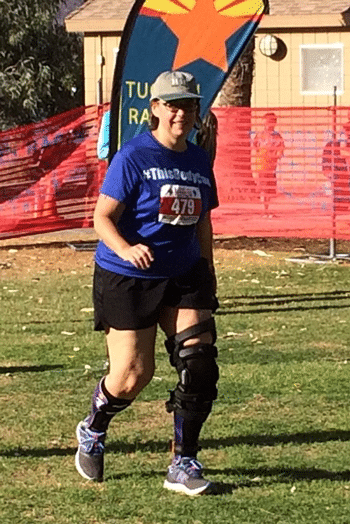The moment I crawled, braceless, out of the sandy-bottomed channel where I’d just completed a 200-yard open-water swim was the moment I became a triathlete. Rather than accept help and be disqualified, I overcame my fear of failure, my fear of looking silly and my excuses for giving up and I finished the race.

Karen Brown
The open-water swim was just one leg of my first mini-triathlon (200-yard swim, four-mile ride, one-mile walk), which I completed in Phoenix in 2015. The water was supposed to be 80 degrees the day of the event so I didn’t worry about surface chop or buying a wetsuit. It turned out to be 70 degrees: I was numb with cold, unused to the chop, ignorant of how to swim straight in open water, and struggling to breathe. To compensate for the current favoring my stronger side, I pushed my weaker side so hard that I somehow shifted my top rib out of position, causing significant pain. About 75 yards in, I didn’t see how I could make it through the swim, let alone the whole race. I had trained freestyle, but had to swim the last 125 yards sidestroke because that was all I could manage. And then when I finished the swim, I realised I couldn’t walk out of the sandy-bottomed channel without my braces. So I crawled. Today, I’m still braced from thigh to toe, but I don’t feel disabled anymore. I’m a triathlete! This is how I did it.
I became an athlete rather late in life. I wasn’t diagnosed with CMT1A until I was 25 and injuries and poor medical advice led me to live my first few decades with extreme physical caution. I began training in my early 40s from a rather sedentary starting position. Ironically, while CMT used to be the reason I stayed on the couch, now it is the reason I stay active. Not only am I discovering how much I really CAN do, but I’m improving my balance and getting stronger, which helps in my everyday life. My CMT is my greatest motivation to stay active. Without it, I sincerely doubt I would ever have considered a triathlon!
For me, finding a great swim coach and physical therapist/trainer has been immeasurably helpful in the swim and run legs. Because I am more consistent with training when others are expecting me at certain times, I take a competitive swimming class at the local community college. I’m also working with a biomechanical physical therapist/certified athletic trainer to improve my core strength, stability and gait, and to learn to RUN (I was only able to walk in my 2015 race). When I finish with PT, I’d like to continue the work with a personal trainer, using 5K races to measure my walking/running improvement between triathlons (one a year, I think). Just getting out there and riding regularly, as well as seeking out additional hardware (an athletic knee brace), has helped me most on the bike. In May 2016, I will be doing my first full sprint distance triathlon.
I find I have to be the tortoise when it comes to my training–slow and steady. My gains are harder-won and more easily lost than those of my “healthy” friends. I get injured more easily and take longer to recover, so it is all about pacing myself and finding a level of activity where I am challenged but not pushed so hard that my fatigue derails me. My favorite resource for training and motivation is the CMTAthletes group on Facebook. What a community of support and inspiration! To build a real-life community of support and accountability, I created a Circle of Friends on the CMTA website and asked my friends and family to give to CMT research in support of my triathlon. That gave me a cheering section, as well as helping raise funds for research. It would have been so easy for me to back out of the race midway, when my self-doubt tried to take me out, but knowing that people I love had already put up their money in support of ME kept me on track.
When I began this adventure, I discovered a number of people in my life who didn’t believe I could actually reach my goal. Some even thought I was delusional to try. I learned how important it is not to let other people tell you what you believe about yourself, even if those people love you and are well-intentioned. Surround yourself with people who believe in you.
At the same time, give yourself permission to modify your goals based on your training experiences. I started out in pursuit of a longer triathlon, and only after months of preparation did I realize I was shooting too high for a first contest. I wanted to quit, really, because I felt so defeated. And I’m utterly grateful that with the support and encouragement of a few dear friends, I stayed in it and shifted my goal to a shorter race. It doesn’t mean I won’t hit that longer goal in time – only that I wasn’t ready for it YET. And that’s okay. Goals are important because they give us something to work towards, but in truth the timelines are irrelevant. It’s the journey that makes us athletes.
My advice for others is to do what you love, and find a way to use that passion to challenge yourself. Train consistently but be kind to your body, because pain does not equal gain for CMTers. Be a tortoise!
Karen Brown is a wife and mom above all else. She also shares her home with her two latest rescue dogs and a tank full of frogs and fish. Karen loves to sing, bake, read, write, and make artsy craftsy things in her spare time.





